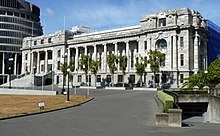| 53rd Parliament of New Zealand | |||||
|---|---|---|---|---|---|
| |||||
 | |||||
| Overview | |||||
| Legislative body | New Zealand Parliament | ||||
| Term | 25 November 2020 – 8 September 2023 | ||||
| Election | 2020 general election | ||||
| Government | Sixth Labour Government | ||||
| Website | www.parliament.nz | ||||
| House of Representatives | |||||
 | |||||
| Members | 120 | ||||
| Speaker of the House | Adrian Rurawhe — Trevor Mallard until 24 August 2022 | ||||
| Leader of the House | Grant Robertson — Chris Hipkins until 25 January 2023 | ||||
| Prime Minister | Chris Hipkins — Jacinda Ardern until 25 January 2023 | ||||
| Leader of the Opposition | Christopher Luxon from 30 November 2021 — Judith Collins until 25 November 2021 | ||||
| Sovereign | |||||
| Monarch | Charles III — Elizabeth II until 8 September 2022 | ||||
| Governor-General | Cindy Kiro from 21 October 2021 — Patsy Reddy until 28 September 2021 | ||||
| Terms of the New Zealand Parliament  |
| 1st | 2nd | 3rd | 4th | 5th 6th | 7th | 8th | 9th | 10th 11th | 12th | 13th | 14th | 15th 16th | 17th | 18th | 19th | 20th 21st | 22nd | 23rd | 24th | 25th 26th | 27th | 28th | 29th | 30th 31st | 32nd | 33rd | 34th | 35th 36th | 37th | 38th | 39th | 40th 41st | 42nd | 43rd | 44th | 45th 46th | 47th | 48th | 49th | 50th 51st | 52nd | 53rd | 54th |
The 53rd New Zealand Parliament was a meeting of the legislature in New Zealand. It opened on 25 November 2020[1] following the 17 October 2020 general election, and dissolved on 8 September 2023 to trigger the next election. It consisted of 120 members of Parliament (MPs)[2] with five parties represented: the Labour and Green parties, in government, and the National, Māori and ACT parties, in opposition. The Sixth Labour Government held a majority in this Parliament. Jacinda Ardern continued as prime minister until her resignation on 25 January 2023; she was succeeded by Chris Hipkins.
The Parliament was elected using a mixed-member proportional representation (MMP) voting system. MPs represented 72 geographical electorates: 16 in the South Island, 49 in the North Island and 7 Māori electorates. This was an increase of one electorate seat from the previous election, as a result of population growth in the North Island. The remaining MPs were elected from party lists using the Webster/Sainte-Laguë method to realise proportionality.[3]
- ^ "Opening of the 53rd Parliament". www.parliament.nz. New Zealand Parliament. Archived from the original on 6 November 2020. Retrieved 25 November 2020.
- ^ "Our system of government". New Zealand Parliament. Retrieved 28 January 2020.
- ^ Wilson, Simon (14 September 2017). "MMP maths: How party vote percentages become seats in parliament". The Spinoff. Retrieved 8 September 2020.
© MMXXIII Rich X Search. We shall prevail. All rights reserved. Rich X Search
